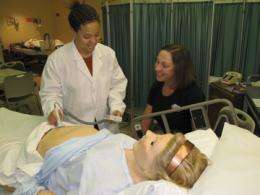High-tech mom helps teach student nurses

(PhysOrg.com) -- Her name is Noelle and she’s about to give birth, but she isn’t a real mother-to-be. Noelle is a simulated mom who’s helping senior nursing students learn how to take care of mothers and newborns during and after childbirth.
Noelle, a name trademarked by her manufacturer, Gaumard Scientific, is a high-fidelity patient simulator that can be programmed to simulate any number of normal or abnormal childbirth conditions, says Linda Scalzo, director of the Nursing Learning Resource Center (NLRC) in the College of Nursing (CON).
The virtual patients - CON now has four adult simulators and two pediatric simulators, plus Noelle’s newborn - don’t replace real patients, says Scalzo, but they do give students a range of experiences with conditions or areas of nursing practice they might not encounter during their clinical rotations in the nursing program.
Nursing students have clinical rotations in both general and specialty areas. The beauty of a high-fidelity simulator is that you can re-create different patient situations, says Scalzo. The students can apply what they’ve learned in textbooks as if they were dealing with an actual patient, with no risk of harm to a real patient, she adds.
Noelle is the first simulator the NLRC has that gives virtual birth. Students can work with a fetal heart monitor and observe the mother’s contractions just as if they were in a real labor and delivery area, says Scalzo. Noelle has vital signs like blood pressure and pulse, has contractions and delivers a newborn simulator. “One of us is in the control room operating the simulation and providing the voice of the patient,” says Scalzo.
Scalzo and the nursing faculty develop scenarios and then program Noelle so that her vital signs and vocalizations reflect an actual condition that could develop during childbirth. For example, Noelle gives the students a chance to experience and react to pregnancy-induced hypertension or a seizure during childbirth. “Nursing students who have an obstetrics clinical experience may not see some of these conditions,” says Scalzo.
Another benefit of the simulators is the consistency of experiences for all students, and the ability to develop scenarios that meet specific learning objectives. In addition to the students caring for Noelle during the simulation, other nursing students observe. After the 10-15-minute scenario plays out, all the students get a debriefing and a chance to ask questions and learn from the experience.
“We ask the students: ‘What happened, what were you thinking, what made you decide to take the action you did?’ This is an important process to develop clinical judgment,” explains Scalzo. “The whole point is to help them develop clinical judgment and become confident nurses.”
Provided by University of Wisconsin-Milwaukee

















